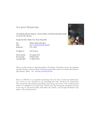TLDR A wide range of proteins are integrated into the skin's protective layer.
The study investigated the composition and formation of the cornified protein envelope in the epidermis, focusing on the role of keratinocyte transglutaminase (TGM 1) defects in autosomal recessive congenital ichthyosis. Mass spectrometry analysis of purified envelopes revealed approximately 170 proteins, with keratins making up about 74% of the total. Non-keratin proteins like keratinocyte proline-rich protein, loricrin, and late envelope protein-7 were also significantly incorporated. The findings suggested that a variety of cellular proteins are integrated into the envelope, similar to observations in hair shafts and nail plates, and explained why the loss of specific envelope components had minimal effects on the epidermis. This protein profile provided a basis for future studies on envelope changes in pathological conditions.
 295 citations
,
March 2016 in “Life Sciences”
295 citations
,
March 2016 in “Life Sciences” Air pollution worsens skin diseases and aging by causing inflammation and oxidative stress.
98 citations
,
December 2015 in “The Journal of Cell Biology” Keratin is crucial for skin barrier formation and affects mitochondrial function.
34 citations
,
March 2009 in “Journal of Investigative Dermatology” 122 citations
,
January 2006 in “Molecular & Cellular Proteomics” Human hair contains many proteins, with some being highly abundant and modified.
425 citations
,
August 2002 in “BioEssays” The cornified cell envelope forms a protective barrier in skin and hair, using specific proteins and lipids to maintain effectiveness.
8 citations
,
January 2023 in “International journal of molecular sciences” Transglutaminase activity is important for skin and is found in both mammals and birds.
29 citations
,
June 2020 in “International Journal of Molecular Sciences” Notch signaling disruptions can cause various skin diseases.
22 citations
,
August 2020 in “Cells” TGM3 is important for skin and hair structure and may help diagnose cancer.
 18 citations
,
January 2020 in “Acta dermato-venereologica”
18 citations
,
January 2020 in “Acta dermato-venereologica” Over 67 genes linked to ichthyosis help improve diagnosis and treatment.
 August 2024 in “Veterinary Dermatology”
August 2024 in “Veterinary Dermatology” Topical ceramide treatment partially improves the skin condition in Jack Russell Terriers with a genetic skin disorder.


